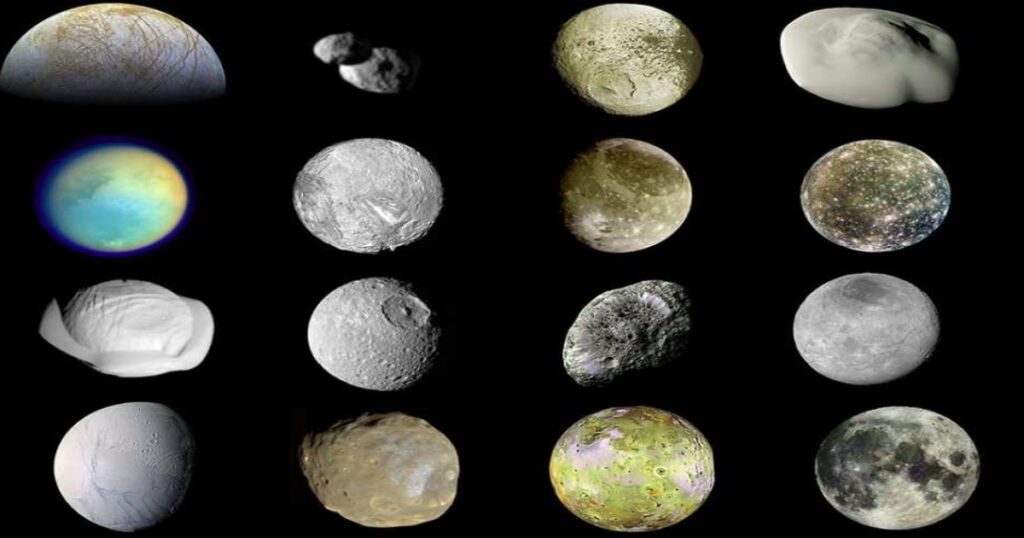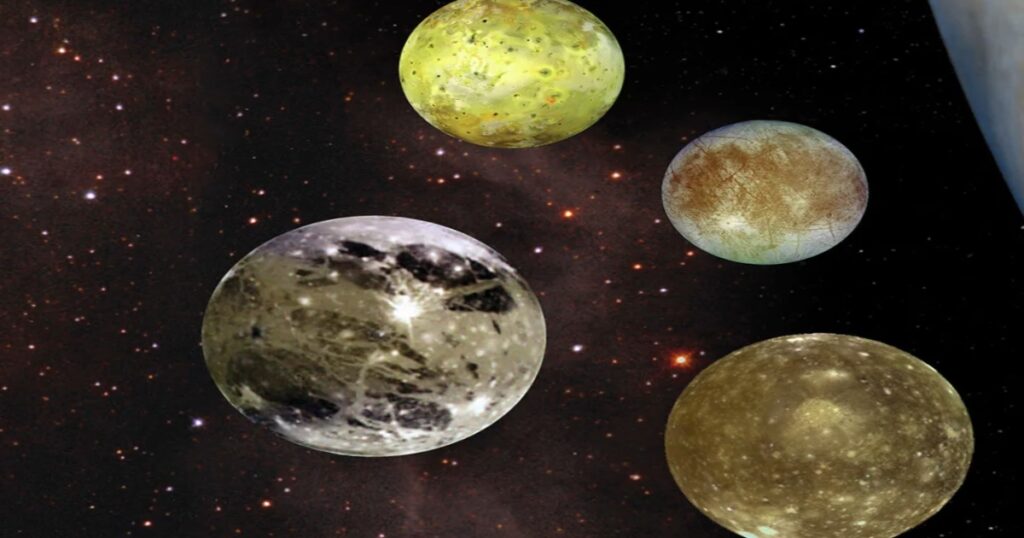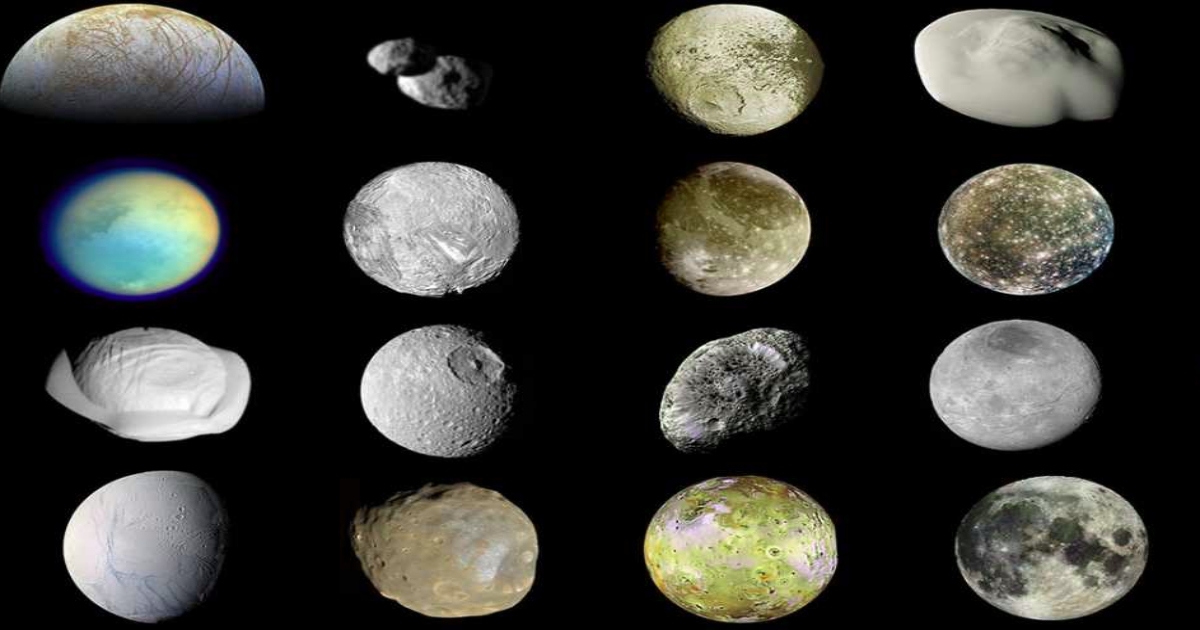Moons, also known as natural satellites, are celestial bodies gravitationally bound to planets or dwarf planets. They orbit their host, accompanying them on their journey around the star. Unlike planets, moons don’t orbit the star directly.
Our solar system has an impressive collection of moons, with planets like Jupiter and Saturn harboring dozens each. Even some dwarf planets, like Pluto, possess moons. Our solar system contains about 290 moons.
Mercury and Venus, are moonless. Earth has one Moon, while Mars has two small moons, Phobos and Deimos. Jupiter has 79 moons, Saturn has 82 moons, Uranus has 27 moons, and Neptune has 14 moons.
Even dwarf planets get in on the act. Pluto, once a planet, has five moons, while Eris, the most massive dwarf planet, has one known moon. Ceres, the largest dwarf planet, is thought to have at least one moon, and Haumea has two moons.

Size: Moons’ diameters can vary from a few kilometers (like some moons of Mars) to thousands of kilometers (like Jupiter’s Ganymede, the largest moon in our solar system).
Shape: Moons can be spherical, like our own moon, or irregularly shaped, especially captured moons.
Mass: Moons’ mass can range from a fraction of Earth‘s moon to more massive than Mercury, like Ganymede.
Volume: Following size and mass variations, Moons’ volumes can differ significantly.
The average distance from their parent planet: The distance between a moon and its parent planet isn’t fixed, it varies considerably. This is because of factors like the size of their parent planet, the number of moons their planet has, and the orbit of the moons.
Temperature: This depends on distance from the Sun, tidal heating, and composition. Temperatures range from scorching hot (like volcanic Io) to frigid cold (like icy Europa).
What’s the Difference Between Planets and Moons?
The key distinction between planets and moons lies in their orbital paths. Planets directly orbit the Sun, while moons orbit a planet or dwarf planet.
Additionally, planets are generally more massive than moons and have achieved gravitational dominance in their orbital neighborhoods, clearing out most other objects in their vicinity. Moons, on the other hand, share their orbital space with other moons or smaller objects.
What is the Life Cycle of Moons?
There are several prevailing theories about the formation of moons. The most widely accepted explanations include:
Giant Impact Theory: A massive collision between a planet-forming body and another celestial object could eject debris that coalesces into moons.
Disc Accretion: During the formation of a planet from a swirling disk of gas and dust, some of the material within the disk can collapse to form moons.
The specific life cycle of a moon beyond its formation depends on various factors like its size, composition, and distance from its parent body. Some moons may experience geological activity like volcanic eruptions or tidal heating, while others remain relatively inert.

What is the Composition of Moons?
Moons exhibit a diverse range of compositions. Rocky materials like silicate minerals are common, while icy moons, composed of water ice, and other ices, are also prevalent. Some moons, like Jupiter’s moon Io, even boast volcanic activity, spewing out sulfurous compounds.
The composition of a moon depends on the materials available in its formation zone and the conditions during its early stages.
What is the Structure of Moons?
The internal structure of moons can vary. Some larger moons, like Earth’s moon, may possess a layered structure with a core, mantle, and crust. Smaller moons might be more homogenous, with their composition relatively uniform throughout. Studying the structure of moons helps scientists understand their formation history and internal processes.
Moons’ Surface:
Rocky and Cratered: Like our Moon, many moons boast surfaces dominated by craters, a result of asteroid and comet impacts.
Icy and Smooth:
Moons like Europa (Jupiter’s moon) may have icy surfaces, potentially hiding vast oceans beneath.
Volcanic and Colorful:
Moons like Io (Jupiter’s moon) showcase volcanic activity, spewing sulfurous compounds that paint their surface with a colorful and otherworldly landscape.
Dusty and Flat:
Some moons, particularly those closer to the Sun, might have dusty and relatively flat surfaces.
Tectonic Features:
Evidence of past geological activity, like cracks or ridges, might be present on some moons.

What are the Types of Moons?
Regular Moons:
These celestial companions are thought to have formed alongside their parent planets from the same swirling disk of gas and dust during the early stages of the solar system’s formation. They share a similar orbital composition with their parent planet, suggesting a common origin. Our Earth’s moon is a prime example of a regular moon.
Irregular Moons:
Unlike regular moons, these celestial hitchhikers weren’t necessarily born alongside their current companions. They are believed to be captured asteroids or other objects that strayed too close to a planet and became gravitationally bound.
Their orbits can be more eccentric (elliptical) compared to regular moons, and their compositions may differ significantly from their adopted planetary family.
The moons Phobos and Deimos, orbiting Mars, are strong candidates for irregular moons. Their small size, irregular shapes, and Martian-incompatible compositions hint at a captured origin.
Shepherd Moons:
These celestial shepherds play a crucial role in maintaining the structure of planetary rings. Their orbital positions within the ring system help confine the ring particles, preventing them from spreading out too far. For instance, several moons like Atlas and Pandora orbit Saturn, acting as shepherds for its magnificent ring system.
Volcanic Moons:
These fiery moons hold the distinction of possessing ongoing volcanic activity on their surfaces. The tidal forces exerted by their parent planets can lead to significant internal friction, generating heat that fuels volcanic eruptions.
Io, a moon of Jupiter, is the most prominent example of a volcanic moon. Its volcanic activity spews out sulfurous compounds, painting its surface with a colorful and otherworldly landscape.
Binary Moons (Double Moons):
In this fascinating scenario, two moons of comparable size are locked in a tight gravitational embrace, orbiting a common center of mass. The Pluto-Charon system is a well-known example of a binary moon system. Charon, Pluto’s largest moon, is nearly half the size of Pluto itself, blurring the line between planet and moon in this unique system.
These categories aren’t mutually exclusive, and some moons may exhibit characteristics of multiple types.
Examples of Moons:
Ganymede (Jupiter’s Moon): Biggest Moon ever
Discovered by Galileo Galilei in 1610, Ganymede is the largest moon in our solar system and the largest moon ever discovered. Ganymede isn’t directly photographed but imaged by spacecraft. Ganymede, an icy moon, Jupiter’s crown jewel, is 5,268 kilometers wide in size (diameter), dwarfing even Mercury.
Ganymede travels around Jupiter at an average distance of 1,070,000 kilometers. Ganymede’s age is likely similar to Jupiter’s at around 4.5 billion years old. It resides in the constellation Sagittarius within the Milky Way galaxy, roughly 778 million kilometers from Earth.
Styx (Pluto’s Moon): Smallest Moon ever
Discovered in 2012 by the Hubble Space Telescope, Styx is the smallest moon of Pluto at only 16 kilometers (10 miles) across. Styx is likely an icy world, similar to other moons orbiting Pluto.
Since Styx’s discovery through snapshots by Hubble, no spacecraft has directly imaged Styx. Styx’s age is estimated to be similar to Pluto’s at around 4.5 billion years old. It resides in the constellation Sagittarius within the Milky Way galaxy, roughly 6.5 billion kilometers from Earth, orbiting the dwarf planet Pluto.
What is the Star’s Influence on Moons?
The star, in our case the Sun, plays a role in shaping the environment of moons. The Sun’s radiation can affect the surface conditions of moons, particularly those closer to the Sun. Additionally, the star’s gravity can influence the orbital stability of moons, particularly for irregular moons captured from distant objects.
What is the Planet’s Influence on Moons?
Planets exert a significant gravitational influence on their moons. This influence dictates the moon’s orbit, can lead to tidal effects that shape a moon’s geology, and may even influence its internal processes like volcanic activity (tidal heating). The moon, in turn, can also affect the planet’s rotation and tilt.
Difference between Moons and Planets:
Moons Vs. Planets
| Feature | Moons | Planets |
|---|---|---|
| Definition | Natural satellites orbiting planets or dwarf planets | Celestial bodies orbiting the Sun (or a star in a broader sense) |
| Formation | Varied theories; Capture from passing objects, formation from debris along with the planet, collision events | Primarily through accretion of dust and gas around a young star |
| Size | Range from tiny dust particles to larger than some planets (e.g., Ganymede, Titan) | Significantly larger than moons (e.g., Earth is 81 times larger than its moon) |
| Composition | Varied; Rock, ice, metal, depending on formation process | Primarily rock, gas, or ice giants depending on size and distance from the Sun |
| Atmosphere | Some moons have thin atmospheres (e.g., Titan), most have none | Most planets have atmospheres, with vast variations in composition and thickness |
| Surface Features | Can have craters, volcanoes, canyons, icy plains depending on composition | Can have diverse surface features like volcanoes, mountains, canyons, polar ice caps, depending on composition and internal heat |
| Magnetic Field | Only a few large moons have weak magnetic fields (e.g., Ganymede) | Most planets have magnetic fields generated by internal motion of molten cores (exceptions: Mercury, Venus) |
| Orbit | Can have circular or elliptical orbits around their host planet | Elliptical orbits around the Sun |
| Number per Celestial Body | A planet can have zero (e.g., Mercury, Venus) or many moons (e.g., Jupiter: 79 moons, Saturn: 82 moons) | A star system typically has one or a few planets |
Conclusion:
Moons are more than just celestial companions; they offer valuable insights into the formation and evolution of planetary systems.
